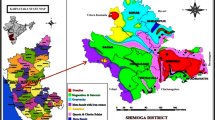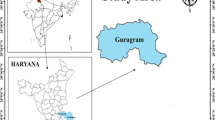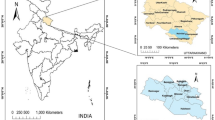Abstract
In this study pin hole dosimeter with deposition based progeny sensors were used to estimate 222Rn, 220Rn and their daughters in the indoor atmosphere. The estimated annual average indoor 222Rn and 220Rn activity concentration were found to be 76.4 Bq m−3 and 93.5 Bq m−3, respectively. The mean value of EEC for radon and thoron was 45.5 Bq m−3 and 1.3 Bq m−3 respectively. The annual effective dose due to indoor 222Rn and 220Rn were found to be 2.9 mSv y−1 and 0.4 mSv y−1 respectively. The estimated effective doses are well below the safe limit as suggested by ICRP for indoor exposure.














Similar content being viewed by others
References
Jansson G (1988) Indoor 222Rn measurements in Sweden with solid-state nuclear track detector technique. Health Phys 54:271–281
UNSCEAR (United Nations Scientific Committee on the Effect of Atomic Radiation) (2008) Sources and effects of ionizing radiation. United Nations, New York
WHO (World Health Organization) (2009) Hand book on indoor radon: a public health perspective. WHO Press, Geneva
Steinhausler F, Hofmann W, Lettner H (1994) Thoron exposure of man: a negligible issue? Radiat Prot Dosim 56:127–131
Nair MK, Nambi KS, Amma NS, Gangadharan P, Jayalekshmi P, Jayadevan S, Cherian V, Reghuram KN (1999) Population study in the high natural background radiation area in Kerala, India. Radiat Res 152:S145–S148
Bangotra P, Mishra R, Kaur K, Kanse S, Mehra R, Sahoo BK (2015) Estimation of EEC, unattached fractions and equilibrium factor for the assessment of radiological dose using pin-hole cup dosimeters and deposition based progeny sensors. J Environ Radioact 148:67–73
Mukesh P, Peter B, Anil KG, Mishra R, Ramola RC (2018) Dose assessment from the exposure to attached and unattached progeny of radon and thoron in indoor environment. Acta Geophys 66:1187–1194
Porstendorfer J (1994) Properties and behavior of radon and thoron and their decay products in the air. J Aerosol Sci 25:219–263
Dankelmann V, Reineking A, Porstendorfer J (2001) Determination of neutralization rates of 218Po ions in air. Radiat Prot Dosim 94:353–357
Butterweck G, Schuler C, Vessu G, Muller R, Marsh JW, Thrift S, Birchall A (2002) Experimental determination of the absorption rate of unattached radon progeny from respiratory track to blood. Radiat Prot Dosim 102:343–348
Chamberlain AC, Dyson ED (1956) The dose to the trachea and bronchi from the decay products of radon and thoron. Br J Radiol 29:317–325
Sannappa J, Suresh S, Rangaswamy DR, Srinivasa E (2019) Estimation of ambient gamma radiation dose and drinking water radon concentration in coastal taluks of Uttara Kannada district, Karnataka. J Radioanal Nucl Chem 323:1459–1466
Sahoo BK, Sapra BK, Kanse SD, Gaware JJ, Mayya YS (2013) A new pin hole discriminated 222Rn/220Rn passive measurement device with single entry face. Radiat Meas 58:52–60
Praminder S, Komal S, Mishra R, Sahoo BK, Bajwa BS (2016) Attached, unattached fraction of progeny concentrations and equilibrium factor for dose assessments from 222Rn and 220Rn. Radiat Environ Biophys 55:401–410
Mishra R, Mayya YS, Kushwaha HS (2009) Measurement of 220Rn/222Rn progeny deposition velocities on surfaces and their comparison with theoretical models. J Aerosol Sci 40:1–15
Mayya YS, Mishra R, Prajith R, Sapra BK, Kushwaha HS (2010) Wire-mesh capped deposition sensors: novel passive tool for coarse fraction flux estimation of radon thoron progeny in indoor environments. Sci Total Environ 409:378–383
Knutson EO (1988) Modeling indoor concentrations of radon’s decay products. In: Nazaroff WW, Nero AV Jr (eds) Radon and its decay products in indoor air. Wiley, New York, pp 161–199
Porstendorfer J (1996) Radon: measurement related to dose. Environ Int 22:563–583
ICRP (International Commission on Radiological Protection) (1993) Protection against radon-222 at home and at work. ICRP Publication-65. Pergamon Press, Oxford
Nero AV Jr (1988) Radon and its decay products in indoor air: an overview. In: Nazaroff WW, Nero AV Jr (eds) Radon and its decay products in indoor air. Wiley, New York, pp 1–53
UNSCEAR (United Nations Scientific Committee on the Effect of Atomic Radiation) (2000) Annex B: exposures from natural radiation sources. United Nations, New York
UNSCEAR (United Nations Scientific Committee on the Effect of Atomic Radiation) (2006) Annex E: sources-to-effects assessment for radon in home and workplaces. United Nations, New York
Marsh JW, Birchall A (2000) Sensitivity analysis of the weighted equivalent lung dose per unit exposure from radon progeny. Radiat Prot Dosim 87:167–178
ICRP (International Commission on Radiological Protection) (2007) The 2007 recommendation of the international commission on radiological protection. ICRP Publication 103. Pergamon Press, Oxford
Mishra R, Sapra BK, Mayya YS (2014) Multi parametric approach towards the assessment of radon and thoron progeny exposures. Rev Sci Instrum 85:022105
ICRP (International Commission on Radiological Protection) (2011) Lung cancer risk from radon and progeny and statement on radon. ICRP Publication-115. Pergamon Press, Oxford
Acknowledgements
The authors would like to express their sincere gratitude to M. P. E. Society’s Undergraduate Research Centre for providing the research Equipments. Also the cooperation extended by all the dwellers of study region is highly appreciated and thankfully acknowledged.
Author information
Authors and Affiliations
Corresponding author
Ethics declarations
Conflict of interest
The authors declare that they have no conflict of interest.
Additional information
Publisher's Note
Springer Nature remains neutral with regard to jurisdictional claims in published maps and institutional affiliations.
Rights and permissions
About this article
Cite this article
Suresh, S., Rangaswamy, D.R., Sannappa, J. et al. Assessment of radiological dose from exposure to attached and unattached fractions of radon (222Rn) and thoron (220Rn) in indoor atmosphere. J Radioanal Nucl Chem 326, 173–184 (2020). https://doi.org/10.1007/s10967-020-07285-4
Received:
Published:
Issue Date:
DOI: https://doi.org/10.1007/s10967-020-07285-4




